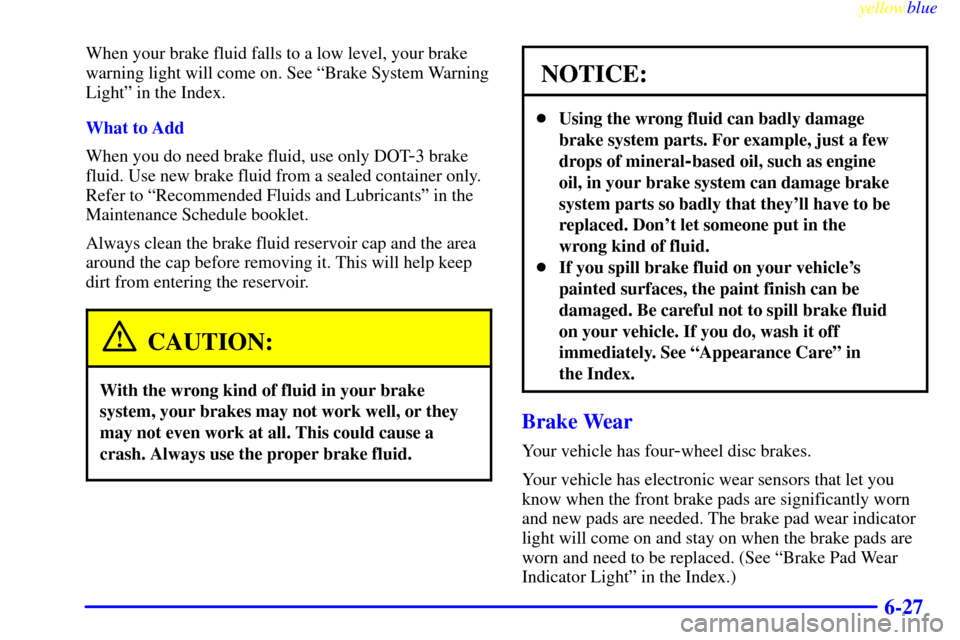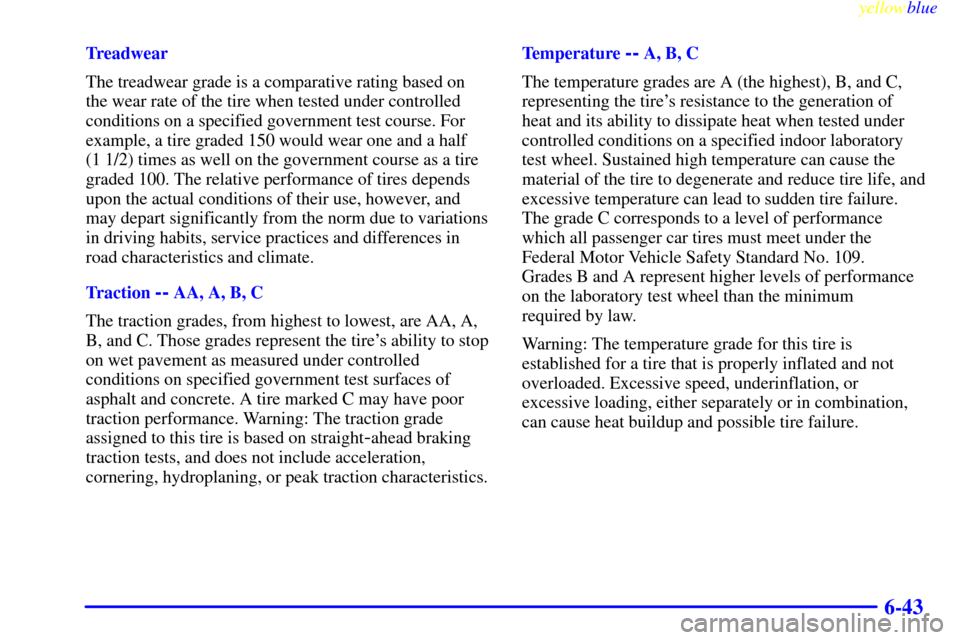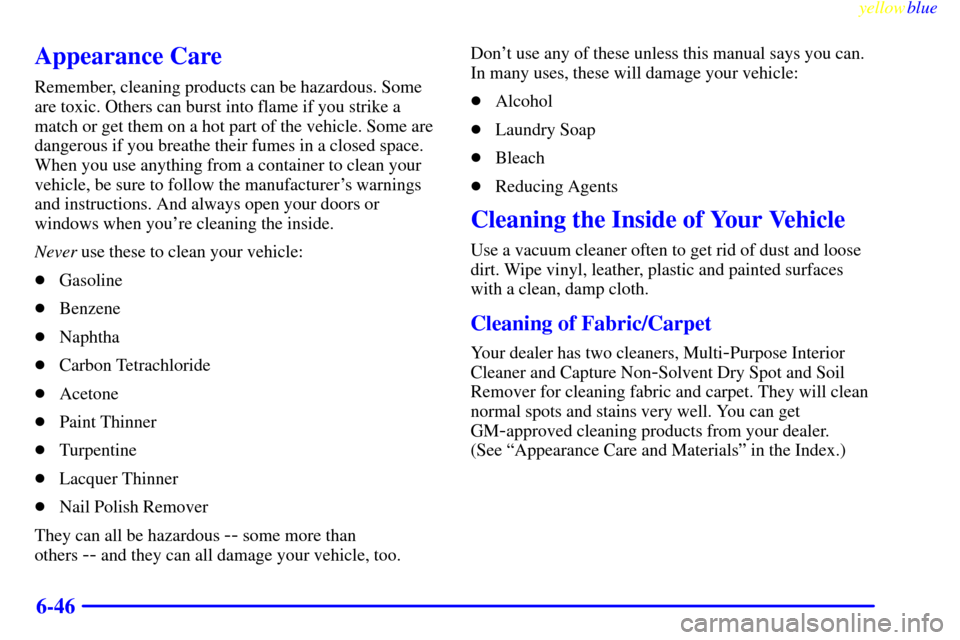Page 260 of 328
yellowblue
6-22
NOTICE:
If you use an improper coolant mixture, your
engine could overheat and be badly damaged.
The repair cost wouldn't be covered by your
warranty. Too much water in the mixture can
freeze and crack the engine, radiator, heater core
and other parts.
If you have to add coolant more than four times a year,
have your dealer check your cooling system.
NOTICE:
If you use the proper coolant, you don't have to
add extra inhibitors or additives which claim to
improve the system. These can be harmful.
Checking Coolant
The surge tank is located behind the air cleaner on the
passenger's side of the engine.
The cooling system when hot is under a lot of pressure.
If the low coolant warning light on the instrument panel
appears, you will need to add coolant.
Page 261 of 328
yellowblue
6-23
CAUTION:
Turning the surge tank pressure cap when the
engine and radiator are hot can allow steam and
scalding liquids to blow out and burn you badly.
Never turn the surge tank pressure cap
-- even a
little
-- when the engine and radiator are hot.
The vehicle must be on a level surface. When your
engine is cold, the coolant level should be at the
KALT/COLD line (seam).
If the light comes on and
stays on, it means you're
low on engine coolant.
For more information, see ªLow Coolant Warning
Lightº in the Index.Adding Coolant
If you need more coolant, add the proper DEX
-COOL�
coolant mixture at the surge tank, but only when the
engine is cool.
CAUTION:
You can be burned if you spill coolant on hot
engine parts. Coolant contains ethylene glycol,
and it will burn if the engine parts are hot
enough. Don't spill coolant on a hot engine.
When replacing the pressure cap, make sure it is
hand
-tight.
Page 265 of 328

yellowblue
6-27
When your brake fluid falls to a low level, your brake
warning light will come on. See ªBrake System Warning
Lightº in the Index.
What to Add
When you do need brake fluid, use only DOT
-3 brake
fluid. Use new brake fluid from a sealed container only.
Refer to ªRecommended Fluids and Lubricantsº in the
Maintenance Schedule booklet.
Always clean the brake fluid reservoir cap and the area
around the cap before removing it. This will help keep
dirt from entering the reservoir.
CAUTION:
With the wrong kind of fluid in your brake
system, your brakes may not work well, or they
may not even work at all. This could cause a
crash. Always use the proper brake fluid.
NOTICE:
�Using the wrong fluid can badly damage
brake system parts. For example, just a few
drops of mineral
-based oil, such as engine
oil, in your brake system can damage brake
system parts so badly that they'll have to be
replaced. Don't let someone put in the
wrong kind of fluid.
�If you spill brake fluid on your vehicle's
painted surfaces, the paint finish can be
damaged. Be careful not to spill brake fluid
on your vehicle. If you do, wash it off
immediately. See ªAppearance Careº in
the Index.
Brake Wear
Your vehicle has four-wheel disc brakes.
Your vehicle has electronic wear sensors that let you
know when the front brake pads are significantly worn
and new pads are needed. The brake pad wear indicator
light will come on and stay on when the brake pads are
worn and need to be replaced. (See ªBrake Pad Wear
Indicator Lightº in the Index.)
Page 281 of 328

yellowblue
6-43
Treadwear
The treadwear grade is a comparative rating based on
the wear rate of the tire when tested under controlled
conditions on a specified government test course. For
example, a tire graded 150 would wear one and a half
(1 1/2) times as well on the government course as a tire
graded 100. The relative performance of tires depends
upon the actual conditions of their use, however, and
may depart significantly from the norm due to variations
in driving habits, service practices and differences in
road characteristics and climate.
Traction
-- AA, A, B, C
The traction grades, from highest to lowest, are AA, A,
B, and C. Those grades represent the tire's ability to stop
on wet pavement as measured under controlled
conditions on specified government test surfaces of
asphalt and concrete. A tire marked C may have poor
traction performance. Warning: The traction grade
assigned to this tire is based on straight
-ahead braking
traction tests, and does not include acceleration,
cornering, hydroplaning, or peak traction characteristics.Temperature
-- A, B, C
The temperature grades are A (the highest), B, and C,
representing the tire's resistance to the generation of
heat and its ability to dissipate heat when tested under
controlled conditions on a specified indoor laboratory
test wheel. Sustained high temperature can cause the
material of the tire to degenerate and reduce tire life, and
excessive temperature can lead to sudden tire failure.
The grade C corresponds to a level of performance
which all passenger car tires must meet under the
Federal Motor Vehicle Safety Standard No. 109.
Grades B and A represent higher levels of performance
on the laboratory test wheel than the minimum
required by law.
Warning: The temperature grade for this tire is
established for a tire that is properly inflated and not
overloaded. Excessive speed, underinflation, or
excessive loading, either separately or in combination,
can cause heat buildup and possible tire failure.
Page 284 of 328

yellowblue
6-46
Appearance Care
Remember, cleaning products can be hazardous. Some
are toxic. Others can burst into flame if you strike a
match or get them on a hot part of the vehicle. Some are
dangerous if you breathe their fumes in a closed space.
When you use anything from a container to clean your
vehicle, be sure to follow the manufacturer's warnings
and instructions. And always open your doors or
windows when you're cleaning the inside.
Never use these to clean your vehicle:
�Gasoline
�Benzene
�Naphtha
�Carbon Tetrachloride
�Acetone
�Paint Thinner
�Turpentine
�Lacquer Thinner
�Nail Polish Remover
They can all be hazardous
-- some more than
others
-- and they can all damage your vehicle, too.Don't use any of these unless this manual says you can.
In many uses, these will damage your vehicle:
�Alcohol
�Laundry Soap
�Bleach
�Reducing Agents
Cleaning the Inside of Your Vehicle
Use a vacuum cleaner often to get rid of dust and loose
dirt. Wipe vinyl, leather, plastic and painted surfaces
with a clean, damp cloth.
Cleaning of Fabric/Carpet
Your dealer has two cleaners, Multi-Purpose Interior
Cleaner and Capture Non
-Solvent Dry Spot and Soil
Remover for cleaning fabric and carpet. They will clean
normal spots and stains very well. You can get
GM
-approved cleaning products from your dealer.
(See ªAppearance Care and Materialsº in the Index.)
Page 295 of 328
yellowblue
6-57
Instrument Panel Fuse Block (Driver's Side)
The fuse block is located below the steering wheel on
the driver's side. Using a screwdriver, loosen the two
trim fasteners under the trim panel and pull the trim
panel away from the instrument panel to access.
Fuse Usage
1 RH and LH Front Side Door Window
Regulator Motor, LH Front Side Door
Window Switch
2 Stoplamp Switch, Cruise Control
Release Switch
3 Automatic Transmission Range Switch,
Automatic Transmission Control Indicator,
Power Steering Control Module, Hazard
Warning Switch, Automatic Transmission
Winter Mode Switch, Transmission Control
Module (TCM)
Page 296 of 328

yellowblue
6-58
Fuse Usage
4 RH and LH Rear Seat Cushion Heater
Relay, Rear Sunshade Motor
5 Transmission Control Module
6 Radio Speaker Amplifier
7 RH and LH Rear Side Door Window
Regulator Motor
8 Headlamp Switch, Turn Signal Switch,
Horn Relay, CD Changer,
Multifunction Relay
9 Windshield Wiper Motor and Relay,
Windshield Wiper and Windshield
Washer Switch
10 Body Control Module (BCM), Heater
Water Auxiliary Pump, Fan Control
Relays, Auxiliary Water Pump Relay
11 Heater and A/C Control, RH and LH
Outside Rearview Mirrors
12 Hazard Warning Switch, Instrument
Cluster, Data Link Connector (DLC),
Stoplamp Switch, Gage Cluster, Heater
and A/C Control.
13 Remote Control Outside Rearview Mirror
Switch, A/C Compressor Relay, Coolant
Fan Test Connector, A/C Load SwitchFuse Usage
14 Cellular Telephone, RH and LH
Windshield Washer Nozzles, Driver and
Passenger Heated Seat Switch, Heater and
A/C Control, Heated Outside Rearview
Mirror and Rear Window Defogger Relay
15 Rear Suspension Leveling Air
Compressor Relay, Instrument Cluster,
Gage Cluster, Cruise Control Switch,
Headlamp Switch, Multifunction Relay,
Passenger and Driver Heated Seat Relay,
BCM, Sunroof Actuator, Automatic Level
Control Sensor, RH and LH Heated Rear
Seat Switch, RH and LH Heated Rear
Seat Cushion Relay, Driver Seat Adjuster
Memory Module, LH Front Side Door
Window Switch, Inside Rearview Mirror
16 Cigarette Lighter (Front and Console)
17 Horn #1 and #2
18 Fuel Pump
19 Electronic Brake/Traction Control
Module
20 Passenger and Driver Heated Seat Relay
21 Daytime Running Lamp (DRL) Relay,
LH High
-Beam Headlamp Relay
Page 298 of 328
yellowblue
6-60
Relay Box
The relay box is located on the lower part of the
instrument panel, to the right of the steering column.Relay Usage
I Daytime Running Lamps
II Automatic Level Control
III Rear Window Defogger, Heated Mirrors
IV Hazard Warning Flashers
V High
-Beam Headlamps II (RH)
VI Horn
VII Parking Lamps and Turn Signal Lamps
VIII Low
-Beam Headlamps
IX Not Used
X Not Used
XI High
-Beam Headlamps I (LH)